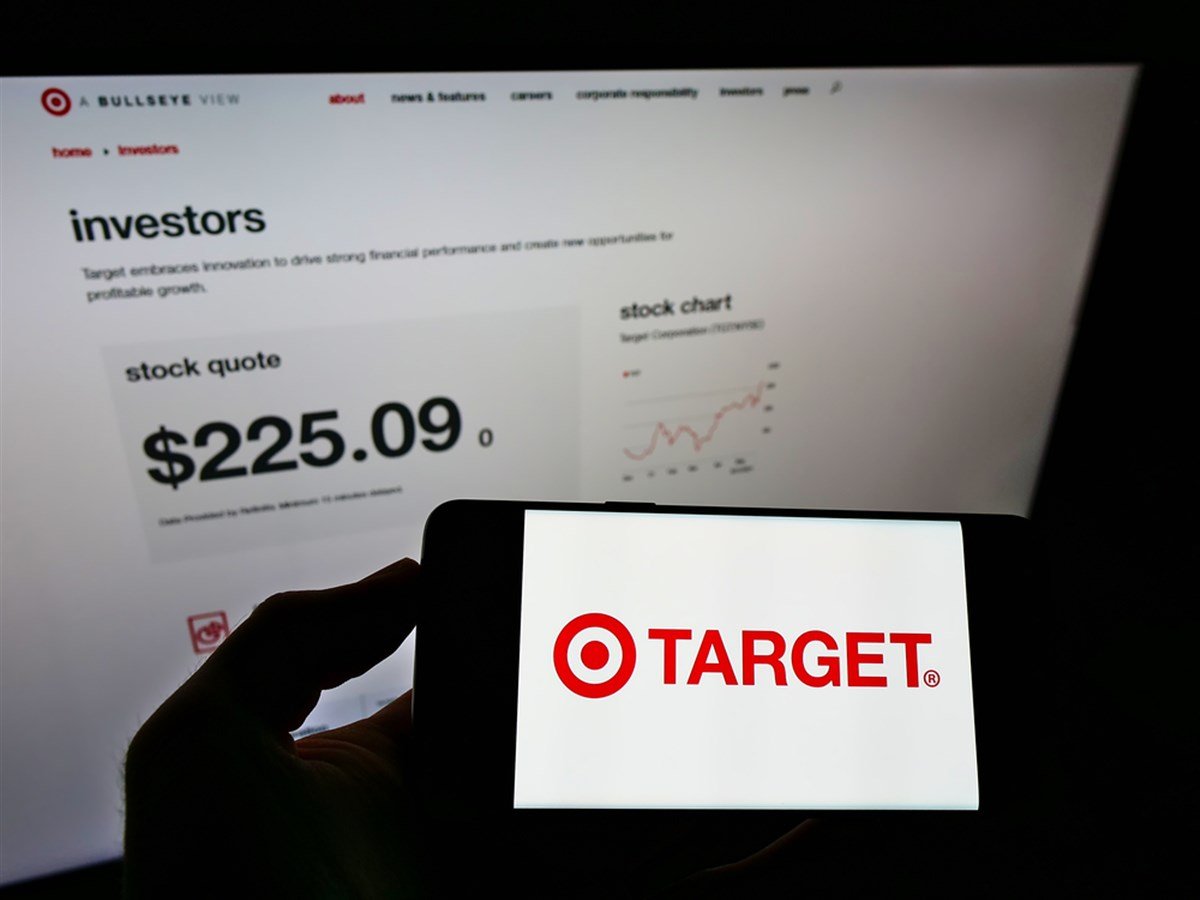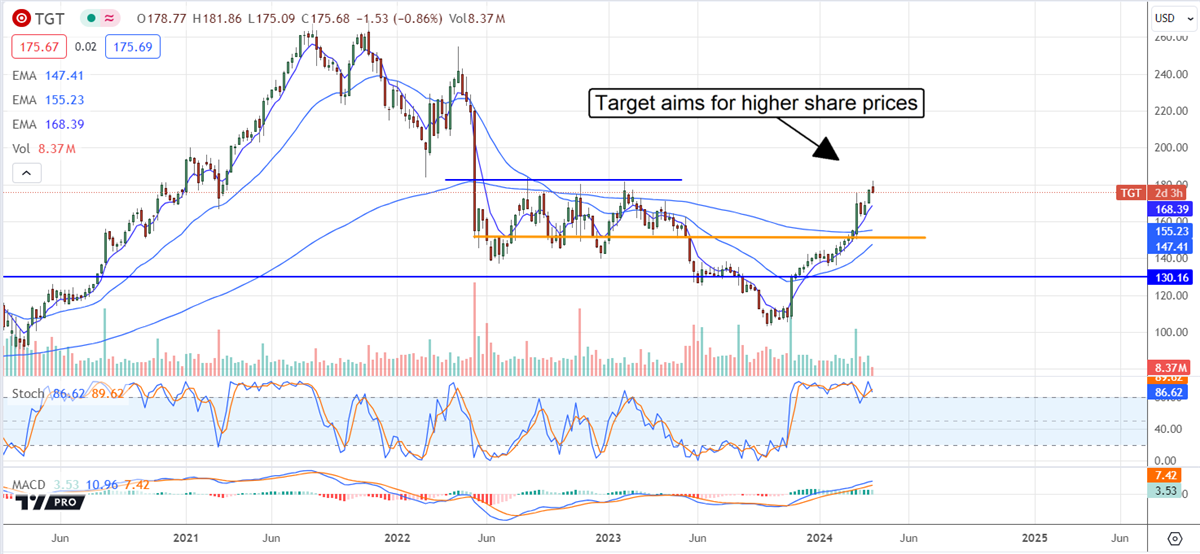 George Dayton founded the Dayton Company in 1902 laying the groundwork for what would eventually become the Target Corporation. However, the first Target (NYSE: TGT)location didn't open until 1962. The idea was to open a low-priced alternative to mainstream retail with higher-quality products than current operations. It was a success, and now Target is the company's sole business and a leading retailer nationally.
George Dayton founded the Dayton Company in 1902 laying the groundwork for what would eventually become the Target Corporation. However, the first Target (NYSE: TGT)location didn't open until 1962. The idea was to open a low-priced alternative to mainstream retail with higher-quality products than current operations. It was a success, and now Target is the company's sole business and a leading retailer nationally.
Today, Target is the 6th largest retailer in the United States in terms of sales volume. It ranks behind Walmart (NYSE: WMT) (the world's largest retailer), Amazon (NASDAQ: AMZN), Costco (NASDAQ: COST), Kroger (NYSE: KR) and Home Depot (NYSE: HD), which all compete in at least some categories. Target operates in a saturated market and competes directly with Walmart by offering better-quality products in a trendier atmosphere.
The company's primary demographic is young mothers with at least some college education and a middle-class income. Because economic conditions influence its shoppers, it is important to stay abreast of corporate and industry trends.
Target Stock Overview
Target's stock price performance in 2024 is bullish to date. The stock rebounded strongly from a price-bottom that formed late in 2023 and is supported by an outlook for normalization.
Over the past two years, rising interest rates and high inflation sparked a consumer shift, and business contraction compounded by above-average shrinkage and margin compression. Today, the company's business is in turnaround mode, with growth expected to resume by the end of the year and profitability outpacing consensus estimates.
The rebound aligns with the long-term trend in the stock price. Target's shares have trended steadily upward for decades, supported by revenue growth, cash flow and capital returns. The company is a solid dividend distributor and distribution grower that has consistently increased the payout for over 50 years. Distributions and increases should continue to support the stock over time because the payout ratio is running near 50%, and earnings are expected to grow.
Target is an undervalued stock relative to the broad market and its closest retail peer, Walmart. In early 2024, the stock traded about 19x earnings, two to three handles shy of the broad market average and at a deep discount to Walmart.
Walmart trades at a much higher 30x valuation, a valuation on the rise because it has gained market share and sustained growth while Target struggled. Among the opportunities today is a price-multiple expansion that may play out for Target over the next few years as the business recovery progresses.
Target's Business Model and Revenue Streams
Target's focus on the shopping experience sets it apart from other retailers, specifically Walmart, which focuses on "Everyday Low Prices" rather than shopping comfort. Target offers a curated selection of chic, low-priced items that balance quality and cost, which are essential concerns for its primary demographic.
Target earns money through merchandise sales and other revenue. Merchandise sales accounted for nearly 98% of the business's revenue in 2023. The other category includes credit card profit sharing, which accounts for less than 3% of the business. The business trends from 2023 included a decline in comp sales offset by increased store count and strength in the "other" category. The forecast for 2024 includes a return to comp store growth by yearend.
Consumer habits will impact business in 2024. Because consumers focus on everyday essentials, health and beauty, and food, Target adjusts inventory to match, reducing discretionary and total inventory and focusing on what sells. Inventory fell 12% by the end of 2023, putting the company in a lean position, ready to invest in this year's best-selling items.
E-commerce and digital are fundamental to Target's long-term success. The company's total e-commerce sales fell slightly in 2023 due to the tough comp to 2022 but remain solid. Same-day services, including pick-up and delivery, grew by 13% and are now 10% of the business.
Financial Health and Performance Analysis
The Q4 2023 financial results reveal a YOY decline in business offset by sequential growth, margin improvement and positive guidance. The first half of 2024 may show little growth, if any, but a pivot is expected in the back half. Revenue growth won't be much annually, but back-half results could show advances in the mid-to-high single-digit range, with additional acceleration expected in 2025.
The real driver of the stock price in 2024 is the margin news. The company attacked its margin issue from multiple angles by lowering inventory, curbing controllable shrinkage and flexing its pricing power by leaning less on markdowns. Selling, General and Administrative (SG&A) expenses increased due to deleveraging but were offset by a 140bps gain in gross margin.
Operating income grew 50% for the year and is expected to remain solid for the foreseeable future. Income is sufficient to sustain the dividend and the healthy balance sheet, but repurchases are unofficially on hold. The company did not repurchase shares in Q4 and may not in Q1, but there is $9.7 billion left under the authorization, and it is likely to resume before the end of the year.
The 2023 balance sheet highlights include a 70% increase in cash due entirely to the reduction of inventory, sales and margin expansion. The assets are up and long-term debt is down, although total liabilities are flat due to lease, tax and “other” liability increases. The net result is a 20% increase in shareholder equity and low leverage ratios. The company's debt-to-equity is just over 1.1x, net debt-to-equity is near 0.8x, and total non-current liability-to-equity is less than 1.7x.
Market Trends and Competitive Analysis
Retail trends in 2024 are strong, but the consumer shift is apparent in the results of names like Walmart and off-price retailers like TJX Companies (NYSE: TJX) and Kohl's (NYSE: KSS). Consumers are targeting lower prices and easy-to-buy daily consumer goods and are unlikely to shift back toward discretionary and higher-priced items until interest rates come down.
Results from Walmart and TJX Companies also show that Target lost share in some categories and demographics but is retaining its core shoppers. In 2024, the focus will be revamping store layouts and optimizing its footprint while controlling inventory. Because consumer habits remain solid in the first half, Target's early guidance will likely be considered cautious in hindsight. Investors might expect outperformance, if not upward revisions, as the year progresses.
The National Retail Federation projects retail sales to grow by 2.5% to 3.5% this year. If Target can outperform its guidance, it will align with the broad market projections. However, Walmart will continue to lead the retail sector. Its position as the number one retailer focusing on low-cost goods will keep it growing. Likewise, the off-price retailers should have a solid year and outpace the broader sector.
Investment Risks and Opportunities
The primary risk for Target at this time is an economic downturn. The company has already weathered the impact of the stimulus bubble bursting, supply chain log jams, and bloated inventory and is in lean, healthy operating conditions. The risk is that the FOMC won't cut interest rates as soon as hoped or at the pace expected, creating a longer runway to recovery.
The worst-case scenario is that pent-up, chained economic demand will sustain inflation and keep the FOMC from cutting rates in 2024. In this scenario, the economy could tip into a recession, and deflation could make it deep. However, such an event would be a buying opportunity in this and most other stocks with solid balance sheets and entrenched businesses.
The opportunity for investors is for the FOMC to continue on its path to rate cuts. Whether the FOMC cuts as soon as expected or at a quick pace, it is on track to reduce rates and spark an economic shift. With rates falling, investors can expect business spending to pick up and sustain healthy labor markets, wage growth and consumer spending. In this scenario, consumers will return to discretionary items, and Target will have another tailwind to drive its business and share price.
Analysts' Ratings and Stock Predictions
Analysts' ratings and price target forecasts have steadily risen since late 2023. The stock is prominently listed among the top 10 Most Upgraded Stocks tracked by Marketbeat and has been gaining ground.
The analysts rate Target stock as a Moderate Buy, up from Hold, and the price target is rising off a low set in Q3 2023.
Consensus in early 2024 suggests the stock is fairly valued near $175, but most fresh targets are above that level. Takeaways from the analysts' chatter are that margin improvement is good, growth is back in the forecast and capital returns are safe: the company may take some time to recover fully, but a full recovery is projected.
A move to the high end of the analysts' range would be a bullish move for the market long-term. A move above $180 would confirm a technical reversal and set the stage for a sustained rally. There is critical resistance at $200 and $240 in this scenario, but a move up to retest the all-time highs set in 2021 is likely.

Dividend History and Shareholder Value
Target has no official dividend policy besides returning capital to shareholders in a manner that provides value and maintains financial health. The company's track record as a Dividend King speaks for itself; management and business can sustain operations in a way that aligns with increasing shareholder value over time.
Target's dividend distribution in early 2024 is $4.40, or about 2.5% yield, with shares near $175.
Target also repurchases shares but did not buy any during Q4 2023. The remaining authorization is worth about 10% of the market cap, with shares at $175, and is substantial support for the market. Investors should expect the company to resume buybacks later in the year and/or upon share price pullbacks.
How to Invest in Target Stock
Investing in Target stock is easy, assuming it is a good fit for the portfolio in question. Any US-approved brokerage account can do it; all it takes is the capital and an order. Brokerage account requirements will vary depending on the type, including regular and margin accounts.
Once the decision is made to buy Target, create a Buy to Open order at the market price. Investors who want a more targeted approach may choose to use a Limit Order instead of a Market Order for the price.
Stay On Track With Target Research
The consumer landscape is fickle and subject to economic conditions, so it's important that investors stay current with Target research and keep up with current events. One way to do this is to subscribe to newsletters, another is to keep track of corporate events on the company's website. Regardless, Marketbeat is always here to provide the most up-to-date data and information available.
Conclusion: Target is on Target for Higher Prices
Target is one of the largest retailers in the United States and is on the path to a business turnaround and full recovery. Shifting consumer habits and inventory glut hurt results in 2022 and 2023, but those days are past. Now, the company is widening its margin and will pivot back to growth by the end of the year. Its cash flow is sound, its balance sheet is healthy and capital returns are safe, so it is a viable choice for investors. Based on the analysts' and technical outlook, Target's share price could retest the all-time highs in 2025.













